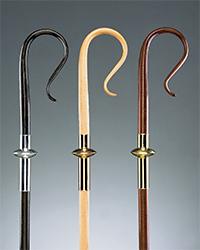

Q. 1. What is a Pastoral Staff and what is it used for?
A. 1. The Pastoral Staff, also known as a crosier, a crozier, a paterissa, or a bishop's staff, is a stylized staff carried by high-ranking Roman Catholics.
The origin of the crozier as a staff of authority is uncertain, but there were many secular and religious precedents in the ancient world. One example is the lituus, the traditional staff of the ancient Roman augurs,[2] as well as the staff of Moses in the Hebrew Bible. Many other types of the staff of office were found in later periods, some continuing to the modern day in ceremonial contexts.
In the Western Church the usual form has been a shepherd's crook, curved at the top to enable animals to be hooked. This relates to the many metaphorical references to bishops as the shepherds of their "flock" of Christians, following the metaphor of Christ as the Good Shepherd.
The staff, used by the Popes in place of a crozier since Pope Paul VI (died 1978), were silver color with a crucifix and corpus at the top. Throughout history, the Popes have not used the Pastoral Staff. Only since Pope Paul VI have they used it.
A bishop usually holds his crosier with his left hand, leaving his right hand free to bestow blessings. The Caeremoniale Episcoporum states that the bishop holds the crosier with the open side of the crook forward, or towards the people . It also states that a bishop usually holds the crosier during a procession and when listening to the reading of the Gospel, giving a homily, accepting vows, solemn promises or a profession of faith, and when blessing people, unless he must lay his hands on them. When the bishop is not holding the crosier, it is put in the care of an altar server, known as the "crosier bearer", who may wear around his shoulders a shawl-like veil called a vimpa, so as to hold the crosier without touching it with his bare hands. Another altar server, likewise wearing a vimpa, holds the mitre when the bishop is not wearing it.
Crosiers are often made or decorated in precious metals, or are at least gilded or silver-plated. They may also be made of wood, though this is more common of the crosier carried by an abbot than of a bishop.